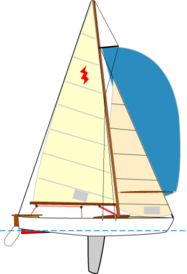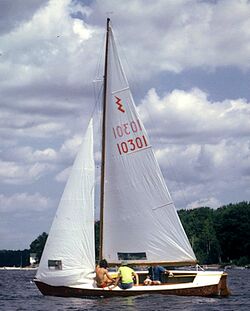Lightning (dinghy)
Topic: Engineering
 From HandWiki - Reading time: 3 min
From HandWiki - Reading time: 3 min
 | |
 | |
| Development | |
|---|---|
| Designer | Olin Stephens |
| Location | United States |
| Year | 1938 |
| No. built | 15,550 |
| Builder(s) | Clark Boat Company Lippincott Boat Works Nickels Boat Works Allen Boat Company Jack A. Helms Co. J.J. Taylor and Sons Lockley Newport Boats Skaneateles Boat & Canoe Mobjack Manufacturing Siddons & Sindle Lofland Sail-craft Eichenlaub Boat WindRider LLC |
| Role | One-design racer |
| Boat | |
| Boat weight | 700 lb (318 kg) |
| Draft | 4.95 ft (1.51 m) with centerboard down |
| Hull | |
| Type | monohull |
| Construction | wood or fiberglass |
| LOA | 19.00 ft (5.79 m) |
| LWL | 15.25 ft (4.65 m) |
| Beam | 6.50 ft (1.98 m) |
| Hull appendages | |
| Keel/board type | centerboard |
| Rudder(s) | transom-mounted rudder |
| Rig | |
| Rig type | Bermuda rig |
| I (foretriangle height) | 20.00 ft (6.10 m) |
| J (foretriangle base) | 6.91 ft (2.11 m) |
| P (mainsail luff) | 24.00 ft (7.32 m) |
| E (mainsail foot) | 10.00 ft (3.05 m) |
| Sails | |
| Sailplan | fractional rigged sloop |
| Mainsail area | 120.00 sq ft (11.148 m2) |
| Jib/genoa area | 69.10 sq ft (6.420 m2) |
| Spinnaker area | 300 sq ft (28 m2) |
| Total sail area | 189.10 sq ft (17.568 m2) |
| Racing | |
| D-PN | 88.4 |
The Lightning is an American sailing dinghy that was designed by Olin Stephens of Sparkman & Stephens, as a one-design racer and first built in 1938.[1][2][3]
An accepted World Sailing class, the boat is one of the most popular one-design sailing classes in the United States and is also raced in several other countries.[1][3]
The design was developed into a smaller boat, as a trainer for the Lightning, the Blue Jay in 1947.[4]
Production
The design has been built by a large number of manufacturers in the United States and also in Canada . There have been 15,550 boats completed and it remains in production by the Allen Boat Company.[1][5][6]
In the past it has been built in the US by the Clark Boat Company, Lippincott Boat Works, Nickels Boat Works, Jack A. Helms Co., Lockley Newport Boats, Skaneateles Boat & Canoe, Mobjack Manufacturing, Siddons & Sindle, Lofland Sail-craft, the Eichenlaub Boat Co and WindRider LLC. It was also built in Canada by J.J. Taylor and Sons Ltd.[1]
Boats have been delivered complete, sold as kits for amateur construction and also amateur-built from plans.[3]
Design
The Lightning is a recreational sailboat, initially built with wooden plank construction and, since the early 1960s, of fiberglass with wood trim. It has a fractional sloop rig with wooden or aluminum spars. The rig employs a backstay, anchored off center, so as to not impede the tiller. If equipped with a wooden mast it has a jumper stay from the mast head to the spreaders. The hull has a foredeck, with a V-shaped coaming, a raked stem, an angled transom, a transom-hung rudder controlled by a tiller and a retractable centerboard. It displaces 700 lb (318 kg) and carries a class-prescribed maximum of 130 lb (59 kg) in centerboard weight.[1][3]
The boat has a draft of 4.95 ft (1.51 m) with the centerboard extended and 5 in (13 cm) with it retracted, allowing beaching or ground transportation on a trailer.[1]
For sailing the design is equipped with a 300 sq ft (28 m2) spinnaker. Mainsail and jib windows are optional for improved visibility and safety.[3]
The design has a Portsmouth Yardstick racing average handicap of 88.4[3] and is normally raced with a crew of three sailors, although it can accommodate six adults.[7][8]
Operational history
The boat has an active class club that regulates the design and organizes races, the International Lightning Class Association.[9] By 1994 there were more than 460 racing fleets in Canada, Europe, South America and the United States.[3]
In a 1994 review Richard Sherwood noted that the design has good freeboard and stability.[3]
Racing
See also
Related development
References
- ↑ 1.0 1.1 1.2 1.3 1.4 1.5 McArthur, Bruce (2020). "Lightning sailboat". sailboatdata.com. https://sailboatdata.com/sailboat/lightning.
- ↑ McArthur, Bruce (2020). "Sparkman & Stephens". sailboatdata.com. Archived from the original on 31 March 2019. https://web.archive.org/web/20190331193635/https://sailboatdata.com/designer/sparkman-stephens.
- ↑ 3.0 3.1 3.2 3.3 3.4 3.5 3.6 3.7 Sherwood, Richard M.: A Field Guide to Sailboats of North America, Second Edition, pages 102-103. Houghton Mifflin Company, 1994. ISBN:0-395-65239-1
- ↑ McArthur, Bruce (2020). "Blue Jay sailboat". sailboatdata.com. Archived from the original on 8 December 2019. https://web.archive.org/web/20191208163015/https://sailboatdata.com/sailboat/blue-jay.
- ↑ WindRider LLC. "Lightning". windrider.com. https://www.windrider.com/collections/windrider-sailboat/products/lightning.
- ↑ Allen Boat Company. "Allen Boat Company". allenboatco.com. http://www.allenboatco.com/.
- ↑ Lightning Class Association, Yearbook 1941
- ↑ "About Lightning - International Lightning Class Association". https://www.lightningclass.org/content.aspx?page_id=22&club_id=93488&module_id=274527.
- ↑ McArthur, Bruce (2020). "Lightning Class (Int)". sailboatdata.com. Archived from the original on 10 November 2020. https://archive.today/20201110010434/https://sailboatdata.com/association/lightning-class-int.
External links
 |
 KSF
KSF
